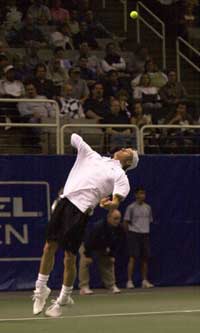<% ns_puts [mkm_getnavbar] %>

The Myth of the Pinpoint Stance
by John Yandell
Still Photos by J Gregory Swendsen
| Page 2 |
Lleyton Hewitt
Now let’s look at a second variation in the Pinpoint, the one used by Lleyton Hewitt. This motion is quite different from Rusedski’s. But does he get any more benefit from the back leg?
|
First, compared to Greg, there are three differences in Hewitt’s version of the Pinpoint. Lleyton has a much deeper knee bend. Second he keeps his back foot in contact with the court as he moves it up into the Pinpoint Stance. Third, he puts the ball of the back foot down on the court, not just the toes. From this position,
Hewitt certainly appears to be in a much better position to push off with the back leg than Rusedski. But again look closely at the action of the feet leaving the court.
Rusedski’s feet seem to come off the court at the same time. But Hewitt’s back foot definitely comes off the court first.
Note that his back foot is much flatter on the court at the deepest part of the knee bend than Greg. But, like Rusedski, Hewitt still comes up on the back toes before leaving the court. This is in contrast to Hewitt’s front foot, which seems to roll off the court from the ball of the foot.
Despite the differences, at the critical moment he leaves the court, his back foot appears to be in a position very similar to Rusedski’s. So again, the question is whether he can really push off with the back leg from the position.
|
If both feet are on the court and one foot pushes off, the other foot should come off immediately. There’s no way to push the body up in the air with one leg and hold it down at the same time with the other.
Again, you can demonstrate this for yourself. Start in the serve ready position and go to your knee bend. Now try to consciously push off the back foot first, and then, immediately afterwards, try to push off for a second time with the front foot.
|
Conceivably, you could push off from the balls of both feet at the same time—but that’s not what Hewitt is actually doing.
Look at the Hewitt animation one more time, because there is a final clue
to the passive role of the back foot. Watch how the back leg turns as it
leaves the court. Notice that it is rotating forward, turning toward the
net as his back foot leaves the ground.
If there were a strong push with the back leg, you wouldn’t see this.
Instead you’d see the back leg leave the ground without rotating. The
force of the push would send the leg straight up at the same angle to the
court. Instead, it is being pulled around and upward by the rotational
forces from the torso before leaving the court.
Hewitt definitely has more vertical push than Rusedski, but this again
appears to be a function of the deeper knee bend and the action of the
front leg. At best, Hewitt’s Pinpoint Stance, like Rusedski’s, seems
irrelevant to the core bio-mechanics of the motion.
Mark Philippoussis
This brings us to the third variation in the Pinpoint Stance, as
exemplified by Mark Philippoussis.
You guessed it, when we look at Philippoussis, once again we see passive
action in the rear leg. Like Hewitt, Philippoussis also brings the back
foot up behind him, and has a deep knee bend and a great vertical push.
But again, take a close look at the footage. It shows that the push is
coming from the front leg.
|
As with Hewitt, you see Phillippoussis come up on the back toes. This
makes it difficult or impossible to push. And, like Hewitt, you also see
the telltale rotation forward of the back leg as the torso rotates.
So Philippoussis isn’t getting anything extra from the Pinpoint either. In
fact, in his case he might actually be losing something.
It’s possible that Philippoussis’s version of the Pinpoint is actually
having a negative impact by interfering with or reducing his body
rotation.
Let’s look at the relation between the Pinpoint and the body rotation in
Philippoussis’s serve and compare it to the rotation in the motion of Pete
Sampras.
In some ways, their motions appear quite similar.
|
If you look at the position of Mark’s feet as the motion starts, they are in a position similar to Pete’s. Note that Mark starts with his rear or right foot well behind him, off the baseline and about 2 and ½ feet to his left.
This stance is similar to Sampras, although somewhat wider. Pete also has his back foot turned a bit further away from the baseline. However, both players are in position to turn much further than either Rusedksi or Hewitt.
And this in fact is what Sampras does. He rotates his torso onto the line <% ns_puts [nsv_get mkm_includes mkm_oldContentFooter_inc] %>





